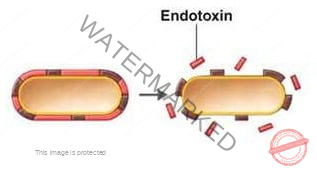Bacterial Metabolic Product
There are two types of toxin (Bacterial Metabolic Product)produced by bacteria.
1. Endotoxin
2. Exotoxin
Endotoxin
- Endotoxin lipopolysaccharide binds to neutrophil and delta neutrophil function by decreasing chemotactic activity and migration and also alter the bactericidal property of neutrophils.
- Endotoxin cannot destroy by autoclave.
- Endotoxins antigenic and cannot be toxoid so that they can not be utilized by antibodies.
Difference between Exotoxin and Endotoxin
| Exotoxin | Endotoxin |
|---|---|
| Protein/polypeptide molecular weight 10000 to 1900000 | Lipopolysaccharide in nature |
| Hear liable (destroyed > 60 oC | Heat stable |
| Actively secreted/diffuse by living bacterial cell into surrounding medium | Form integral part of the cell wall so released only on disruption of bacterial cell |
| Exotoxins are highly antigenic so that they stimulate formation of antitoxin which neutralizes toxins. | Very weak antigenic so antitoxin is not formed but antibodies against polysaccharide are raised |
| Toxins are converted into toxoid by formaldehyde. | Can not be toxoided |
| Enzymatic in nature | No enzymatic action |
| Exotoxin produces specific pharmacological effect for each exotin | Non-specific action to all endotoxins |
| Very high potency | Low potency |
| highly specific for particular tissue example tetanus toxin for CNS | Non-specific in actionPrepared by ThePharmapedia.com |
| Exotoxin do not produce fever in host | Endotoxin usually produce fever |
| Exotoxins are produced mainly by gram-positive bacteria and also by some gram-negative bacteria | Endotoxins are mainly produced by gram-negative bacteria Prepared by ThePharmapedia.com |

Exotoxin
Exotoxin are Actively secreted/diffuse by living bacterial cell into the surrounding medium following lysis.
Examples of endotoxin-producing bacteria are: Salmonella typhi (Typhoid), Vibrio cholerae (Cholera). Streptococcus pneumoniae (sepsis)

Endotoxin
Endotoxins are an integral part of the cell wall and released only on disruption of a bacterial cells.
Examples of exotoxin producing bacteria are:Clostridium botulinum (Botox), Clostridium tetani (Tetanus), Corynebacterium diphtheriae (Diphtheria).
Multiple Choice Question (MCQ)
Q1. Which toxin can be converted into toxoid by formaldehyde?
a. Exotoxin
b. Endotoxin
c. Both
d. None
Ans: A
Q2. The chemical nature of endotoxin is
a. Lipopolysaccharide
b. Protein
c. Carbohydate
d. None of these
Ans: A
Q3. ………………….is the toxin produced inside the bacteria itself as a part of their metabolism?
a. Exotoxin
b. Endotoxin
c. Both
d. None
Ans: A

Comments are closed